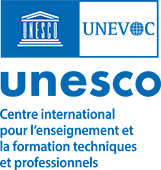
Le Centre International UNESCO-UNEVOC: Qui nous sommes | Ce que nous faisons | Nous rejoindre | Nous contacter
Le Réseau UNEVOC: En savoir plus sur le Réseau | Répertoire du Réseau UNEVOC
Espace Membres: Tableau de bord du Centre UNEVOC
Domaines thématiques: Inclusion et jeunes | Innovation et avenir de l'EFTP | Engagement du secteur privé | Les ODD et l'écologisation de l'EFTP
Nos programmes et projets clés: BILT: Connecter innovation et apprentissage | Renforcer la résilience de l’EFTP | Programme pour le leadership en EFTP | Journée mondiale des compétences des jeunes
Activités passées: Réponse COVID-19 | i-hubs: Former des pôles d'innovation | Forums mondiaux de l'EFTP | Conférences virtuelles | YEM Portail de connaissances
Nos services et ressources: Publications | Forum TVET | Profils nationaux d'EFTP | Glossaire TVETipedia | Pratiques prometteuses | Toolkits for TVET Providers | Formation à l’entrepreneuriat
Journal et événements: Grandes Manifestations EFTP | Journal UNEVOC
Technology which provides for electronic input, storage, retrieval, processing, transmission and dissemination of information.
 Source:
Source: Cedefop, Glossary. Terminology of European education and training policy, (accessed 03/2023)
Cedefop, Glossary. Terminology of European education and training policy, (accessed 03/2023)
Information and Communication Technologies (ICT) refer to a range of technologies and tools used to create, collate and communicate information and knowledge. ICTs are used in daily life to prepare documents, talk to others by phone, listen to radio and watch television programmes. Some ICTs involve one-way communication, while others facilitate two-way communication. Some can include only one medium (e.g. telephone), while others can handle more than one medium (e.g. computer and television).
For the purpose of statistical reporting and in the context of this guide, information and communication technologies (ICT) is defined as a diverse set of technological tools and resources used to transmit, store, create, share or exchange information. These technological tools and resources include computers, the Internet (websites, blogs and emails), live broadcasting technologies (radio, television and webcasting), recorded broadcasting technologies (pod casting, audio and video players, and storage devices) and telephony (fixed or mobile, satellite, visio/video-conferencing, etc.).
Pour en savoir plus et contribuer